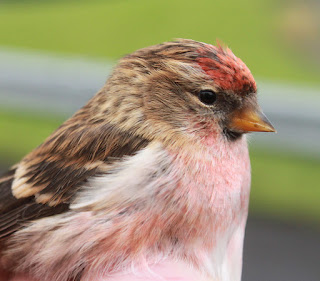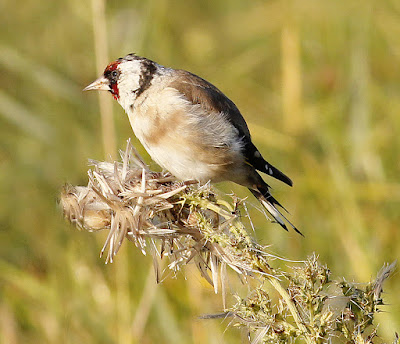Here’s wishing Seasonal Greetings to readers old and new of Another Bird Blog. The blog is taking a few well-earned days off to join in the festivities before returning soon. In the meantime there are a few highlights and favourites from the year gone by with words and photographs by way of illustration.
In January 2015 we left the grey skies of England and escaped south for a few weeks to the warmth of Lanzarote, Spain. One thousand eight hundred miles from home on the island of wide blue skies the weather was spring-like with many birds engaged in the throes of breeding.
Berthelot's Pipit, Lanzarote - January 2015
The Desert Grey Shrike is very common on Lanzarote. It is also very vocal and fearless, as proven when I watched one attack and chase a feral cat from an area where both of the adult shrikes fed youngsters out of the nest.
Desert Grey Shrike
The centre of a thorny bush in the desert like landscape makes for a secure nesting site; this female had yet to lay eggs but was pretty insistent on staying put just yards from the car window.
Desert Grey Shrike
Lanzarote - January 2015
During February and March Andy and I began to catch both Lesser Redpolls and Siskins at the ringing site near Oakenclough, where to their credit United Utilities invested a large amount of cash in improving the site by removing rhododendron and then replanting. The redpoll passage was more noticeable than the number of Siskins, but by early April the less than spectacular movement of both was virtually over.
Siskin
Lesser Redpoll
March and April saw the usual spring arrival of Wheatears, coupled in March with a very noticeable arrival of Stonechats whereby to see at least half-a-dozen Stonechats lined up along a barbed wire fence is fairly unusual. Meanwhile the cool, windy spring restricted opportunities for catching Wheatears with a measly three my sum total for the year.
Stonechat
Wheatear
The wet and cool spring didn’t help Skylarks much. At Pilling two out of four Skylark nests failed at the egg stage when heavy rain washed out the nests, a third proved inconclusive, with only the fourth nest being successful at “ready for fledging” stage.
Skylarks
Skylark
“Travel broadens the mind” goes the well-worn phrase so the month of May found Sue and I widening our horizons by spending a couple of weeks in Menorca. When we come back to Earth next time we both want to be landed on this beautiful island and sit in the plaça drinking coffee all day - in between birding (and shopping!) of course.
Alaior - Menorca 2015
Audouin's Gull
Egyptian Vulture
Back home during June and July around the local patch were a few unexpected Lapwing chicks. Rather perversely the wet spring for farmers and birders proved to be something of a blessing to the beautiful bird which likes wet meadows but struggles to survive the modern world of intensive farming.
Lapwing - 2015
Lapwing - 2015
During late May, June and July just four timed visits to a local Sand Martin colony produced reasonable early season catches without proof of a good breeding season in the way of many youngsters. We suspect the cool and wet year played havoc with the martins just as it did with many other species during 2015.
Sand Martin
It might seems strange to mention the common Bullfinch as a highlight but the single bird I caught at Oakenclough on the 28th August was the first I’d handled in almost thirty years. Yes, the Bullfinch is that scarce in this part of Lancashire.
Tree Pipit was top of the pops at Oakenclough on 16th August when during a quiet ringing session four of the striking pipits found their way to the mist nets. Meanwhile the other fifteen birds of the day divided between a few each of Willow Warblers, Lesser Redpolls, Goldcrests and titmice.
Tree Pipit
Bullfinch
September saw Sue and me adventuring in Skiathos, Greece, yet another beautiful sunny island. There’s a definite island theme going on here.
Skiathos - 2015
Skiathos isn’t a famed birding spot, thank goodness. But it may well be the best place on Earth to watch Eleonora’s Falcons in action. On other days I managed to find a good mix of species during and after a particularly violent and historic thunderstorm which wrecked the neighbouring island of Skopelos. Who says it only rains in Britain?
Yellow Wagtail
Eleonora's Falcon - Skiathos 2015
October proved a fine autumn month for birding and ringing before the downhill slide which brought major floods to North-West England. By the end of October our ringing sessions at Oakenclough had provided 60 Redwings, a handful of Fieldfares, continued redpolls and even a couple of bonus Sparrowhawks to enliven unwary fingers.
Sparrowhawk
Redwing
There’s not much to say about November and December other than I wish it would stop raining and blowing a Hooley. We’ve managed three ringing sessions while the birding has been dire.
BBC Weather Forecast, NW England - 24th December 2015
Roll on 2016 for longer days, brighter weather, birding and blogging. And SUNSHINE.
Linking today with Eileen's Saturday.































































.jpeg)






.jpg)













